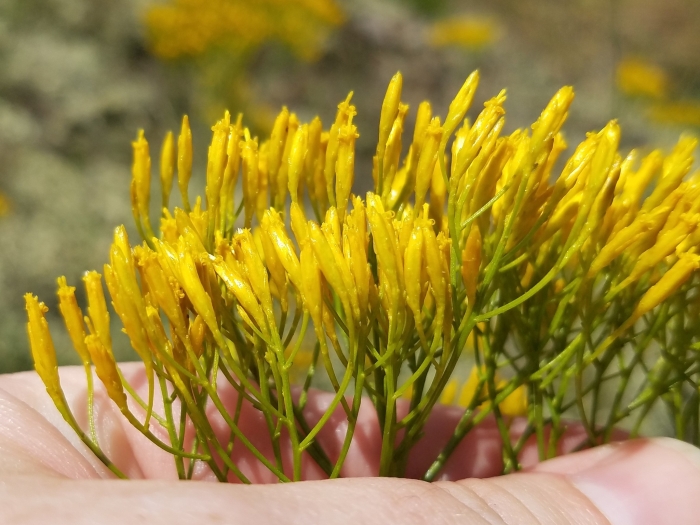Nuttall’s Rayless Goldenrod
(Bigelowia nuttallii)
Nuttall’s Rayless Goldenrod (Bigelowia nuttallii)
/
/

Leila Dasher
CC BY 4.0
Image By:
Leila Dasher
Recorded By:
Copyright:
CC BY 4.0
Copyright Notice:
Photo by: Leila Dasher | License Type: CC BY 4.0 | License URL: http://creativecommons.org/licenses/by/4.0/ | Rights Holder: Leila Dasher | Publisher: iNaturalist | Date Created: 2021-09-06T13:25:13-07:00 |























Estimated Native Range
Summary
Bigelowia nuttallii, commonly known as Nuttall’s Rayless Goldenrod, is an evergreen perennial herb native to pine savannas, sandhills, and coastal plains in the Southeastern United States. It typically grows up to 70 cm (28 inches) tall and often forms dense clumps. The majority of its leaves are arranged in a basal rosette, with smaller, narrower leaves on the erect stems. The plant produces flower heads that are small, yellow, and arranged in flat-topped clusters, each head containing 2-6 disc florets but lacking the ray florets typical of many goldenrods. Bigelowia nuttallii blooms from late summer to fall, and while the flowers are not particularly showy, they add a subtle charm to the landscape.
This plant is valued for its drought tolerance and ability to thrive in poor, sandy soils, making it suitable for xeriscaping and naturalistic plantings. It is also used in restoration projects to stabilize soils and support native pollinators. In cultivation, it requires minimal maintenance, preferring full sun to part shade and well-drained soils. While it is not commonly found in nurseries, it can be propagated by seed or division. Potential problems include root rot in poorly drained soils. Nuttall’s Rayless Goldenrod is not known to be invasive and does not have aggressive roots, making it a responsible choice for ecologically-minded gardeners.CC BY-SA 4.0
This plant is valued for its drought tolerance and ability to thrive in poor, sandy soils, making it suitable for xeriscaping and naturalistic plantings. It is also used in restoration projects to stabilize soils and support native pollinators. In cultivation, it requires minimal maintenance, preferring full sun to part shade and well-drained soils. While it is not commonly found in nurseries, it can be propagated by seed or division. Potential problems include root rot in poorly drained soils. Nuttall’s Rayless Goldenrod is not known to be invasive and does not have aggressive roots, making it a responsible choice for ecologically-minded gardeners.CC BY-SA 4.0
Plant Description
- Plant Type: Herb
- Height: 1-2 feet
- Width: 0.25-0.5 feet
- Growth Rate: Moderate
- Flower Color: Yellow
- Flowering Season: Summer, Fall
- Leaf Retention: Evergreen
Growth Requirements
- Sun: Full Sun, Part Shade
- Water: Low
- Drainage: Fast
Common Uses
Drought Tolerant, Low Maintenance, Showy Flowers
Natural Habitat
Pine savannas, sandhills, and coastal plains
Other Names
Common Names: Nuttall’s Rayless-Goldenrod, Nutt.’s Rayless-Goldenrod
Scientific Names: , Bigelowia nuttallii,
GBIF Accepted Name: Bigelowia nuttallii L.C.Anderson